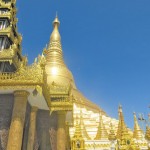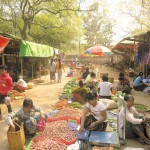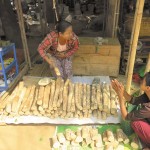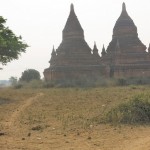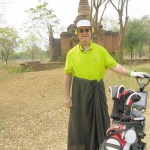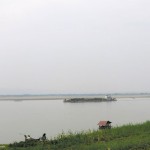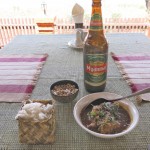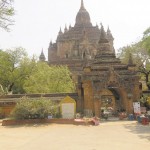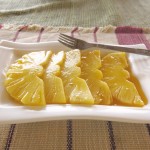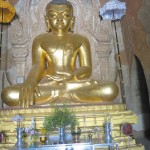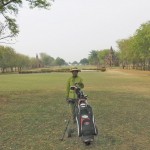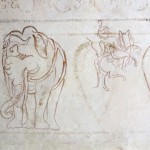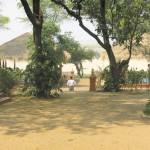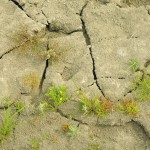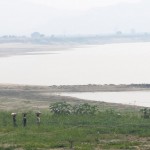Pleasant Surprises In Myanmar
This is the second in a three-part series.
Flying into Myanmar, the last thing I expected was to fall in love … with a river.
But that I did, with the mighty Irrawaddy. It wasn’t quite love at first sight, but it didn’t take long after sitting down at a riverside cafe in Bagan to realize this beautiful river is one of the world’s great geologic features. I rate it on a par with the Grand Canyon – both required eons of water flow to create and both leave my mouth agape in wonder. More on that later.
- A glimpse of Shwedagon Pagoda in Yangon. Don Chapman photos
- Women sell produce at an open market in Bagan
- A woman at a Bagan market sells the tree branches used to make thanaka face paste
- One of the 2,200 ancient pagoda sites in Bagan
- The author in a longyi at Bagan Golf Club
The grand Irrawaddy was just one of many surprises on a 10-day stay in the land formerly known as Burma that included the East-West Center’s International Media Conference in Yangon.
Another pleasant surprise was the eagerness of Myanmar folks to converse with foreigners. That was evident when, in a neighborhood restaurant in Yangon, I was approached by a Myanmar merchant sailor. He asked where I was from.
“Hawaii, USA.” “OK, please come drink with us.”
So I joined him and three other seamen for a couple bottles of Myanmar beer – a fine locally brewed lager that goes down easy. The sailors enjoyed telling me of their world travels, showing off their English skills and asking about my life. When we parted it was with Buddhist bows and guy hugs.
During Myanmar’s five decades of military dictatorship that ended in 2011, “the generals” tended to frown on tourism. Strangers from foreign lands bringing in crazy ideas – freedom, rule of law, democracy, human rights?! – was the last thing they wanted. A few foreigners did come, of course. Karen Knudsen, the East-West Center’s director of external affairs, just made her 16th visit, the first coming in 1976 with husband Greg. Hearing the story of my meeting two teen street girls who became my tour guides for a day, and of sharing beers with the four seamen, Karen started to tear up.
“All of that would have been illegal just three years ago,” she said. “Whenever I spoke with a local person before, they would be questioned by the military. When I left, I always worried what might happen to them.”
Those sailors were fairly typical in this new Myanmar, with waiters, taxi drivers and even teens at a Yangon water park happily engaging in previously forbidden interaction and conversation.
But wade in the shallow end of this pool. Politics, and the generals, still stir zip-lip discomfort in many who were so recently repressed.
If you’re thinking about visiting, a few things to know:
Getting there isn’t easy. I flew China Air from Honolulu through Taipei going over, and coming back through Bangkok (and its sprawling new airport – to get some exercise I walked for 90 minutes during a layover and didn’t see all of it) and back through Taipei. Both ways it was about 24 hours of traveling.
Unlike, say, Japan, where you just show up with a U.S. passport and get an entrance visa, Myanmar is stricter. Although I had a letter of recommendation from the Interior Ministry, okaying me for a visa to attend the East-West Center conference, that was no guarantee of receiving a visa upon arrival. So I used CIBT, a service in D.C., to walk my passport to the Myanmar embassy and secure a visa. It cost $150 for expedited service, but was quick, efficient and one less headache.
The 30-minute drive from Yangon International Airport to the Panda Hotel is along leafy, winding Pyay Road past huge lakes.
While you can find ATMs in Yangon – the Panda had one in the lobby – most businesses do not accept travelers checks or credit cards. Thus, the bulk of my trip had to be paid in advance, wired through Singapore, and I had to bring in enough cash to last for 10 days. The best exchange rates, I’m told, are no longer at black market places. I traded dollars for kyats at the hotel – $1 roughly equals 1,000 kyat (pronounced chat).
I’m not in the habit of recommending travel agents, but in preparing to visit such a foreign country I was grateful for the attention to detail and prompt email replies from Mr. U Min Lwin Oo (aka Mr. Min Min), managing director of Myanmar Frangipani Travels & Tours in Yangon. He booked hotels in Yangon and Bagan, drivers to and from airports, and a tour driver and round of golf in Bagan.
Likewise, the Panda is clean, with a good restaurant (breakfast buffet is part of the package) and located a short cab ride to the incredible Shwedagon Pagoda, of which I had a view from my room. Whether it was glimmering in the sun or aglow in spotlights after dark, I never tired of looking up and seeing Shwedagon. More on that in a moment.
Speaking of views: Every afternoon on the short walk back from the conference site, I paused to watch barefoot young men in a sandy side lot of the hotel playing “chin lo,” a cross between soccer and volleyball, played three-a-side with a small plastic or wicker ball. Some remarkable athletic moves, and just fun to watch.
I was there during a cusp between seasons – there are three in Myanmar. Weather every day was in the upper 80s, but with light, cooling breezes. The monsoon season starts late May/early June with heavy rains and humidity; the dry season starts in November with lower temperatures, and then the heat returns in the spring.
- Three women return from the market to their stilted huts (not pictured to the right) along a wide bend in the Irrawaddy River
If you’re in Yangon on a Friday evening, it’s tough to beat pupus and chilled beverages at the Yangon Sailing Club on Lake Inya. Lots of ex-pats to chat with, and a delightful place to catch a brilliant red sunset for which Myanmar is legendary.
As mentioned previously, it’s possible to get a boat ride on the Yangon River. Inquire at The Strand Hotel (about a 15-minute, $3 taxi ride from the Panda).
Across from The Strand I enjoyed a really good lunch at the wharfside Junior Duck restaurant, including fantastic steamed whole river fish.
Not to be missed is Shwedagon Pagoda. Its earliest roots are said to date from shortly after the Buddha achieved enlightenment in 600 B.C. Over the millenia it has grown, and the grounds now comprise 120 acres and the gold-plated top rises 326 feet – something like 7 tons of gold and gold leaf were used. The top of the stupa is encrusted with 4,531 diamonds, the largest and topmost at 72 carats. Entry fee is $8, and crisp U.S. bills are preferred. Here as at other Buddhist shrines in Myanmar, no socks or shoes are allowed inside. (Tip the shoe lady before setting off to view the temple, and bring wet wipes for foot cleansing afterward.) I hired a guide for $10, and it was money well spent – otherwise it would have been one big golden blur of buddhas and stupas. If you know what day of the week you were born, visit your day’s “corner.” I’m a Sunday boy, and was instructed to dip water from a fountain and pour a small splash over the Sunday buddha’s head for each year I’ve been alive, plus one more. It took a while, and careful counting, but the guide said I am now blessed forever. Which is nice.
Following the four-day media conference, I flew 80 minutes north to Bagan in a Bagan Air turbo-prop for three days and two nights.
The Bagan plain was once the home of a wealthy culture. Between the 11th and 13th centuries, it’s said more than 10,000 Buddhist pagodas, temples and monasteries were built as kings and queens sought to “make merit.” It’s also said that over-spending on religion led to the kingdom’s decline – not enough left for self-defense and domestic issues, though it was good for the “construction industry” of the time (sound familiar?). Today, more than 2,200 of these structures remain, some small enough to fit in your driveway, others with immense footprints and rising hundreds of feet into the sky, housing amazing golden buddhas and ceiling paintings. Mr. Min-Min arranged for a driver to take me from pagoda to pagoda, for which I was grateful when I saw people riding rented bicycles for miles and miles in the dusty Southeast Asian heat. By the way, I was told that seeing Bagan from a hot-air balloon is the way to go, though I enjoyed the ground experience.
That said, I was a bit put off by vendors selling what I’d call “tourist crap” outside pagoda after pagoda – anybody want a cheap replica jersey of Brazilian soccer star Ronaldinho? On one hand, I recalled the New Testament story of Jesus “cleansing the temple” in Jerusalem of those who did business there. On the other, this is a poor country and people have to scrape out a living somehow.
The driver also took me to an open-air market where women spread produce and other wares on blankets on the ground. Stalls featured Myanmar lacquerware, jade and bronzed figures, as well as clothing. I bought a longyi, the barrel-shape cloth that is cinched at the waist and is standard waist-down wear for men in Myanmar. Haggling over prices is the norm here – never buy anything at the first price quoted.
It wasn’t exactly Augusta’s Magnolia Lane, but the approach to the Bagan Golf Club down a mile of tunnel-arched acacia trees nicely mirrored the peaked arches of the many pagodas and temples. The club’s holes wind between pagodas small and large, and I often found myself saying, “Just aim it at the stupa.” It’s not fancy, and the grass was a bit thin, but holes are interesting and greens are good. With a caddie, rental clubs and sleeve of balls, the cost for walking nine holes was about $65.
Back to the Irrawaddy, also called Ayeyarwady, where my thoughts often drift.
My first glimpse came on the first day in Bagan, during a break in pagoda visits. My driver took me through scrub brush and tall grasses on a sandy one-lane road. Coming to a blind bend, he tooted his horn as warning for potential approaching vehicles. Where the heck is he taking me? I wondered. And then we arrived at a lovely open-air riverside restaurant, the Ayeyarwady River Terrace. Over plump river shrimp in a rich, red curry, pinepple slices roasted in honey for dessert, and a couple of tall Myanmar lagers (did I mention it goes down easy?), my eyes gradually took in the river – what it is now and what it will be in the rainy season. Still of impressive width now, a half mile at least in places, the sandy flood plains on either side of the river stretch off to the horizon, a mile or more.
At the Bagan Thande Hotel – where the indoor dining room is actually a two-story cottage built for the Duke of Windsor, later King Edward VII, in 1922 – I took meals at an outdoor restaurant on a bluff above the Irrawaddy and watched all manner of commercial boats large and small motoring up and down the placid river.
The Irrawaddy begins at the confluence of the N’mai and Mali Rivers that run down from Himalayan glaciers, and then meanders 1,350 miles through Myanmar, fed along the way by countless tributaries, spreading into a massive delta region south of Yangon before flowing into the Andaman Sea. Its name is said to derive from the Sanskrit airāvatī, meaning “elephant river.” It is big, the source of life, culture and history for a country inhabited by homo sapiens for more than 10,000 years, and 700,000 years before that by homo erectus, and influenced every day by that river.
On my final afternoon in Bagan, I hiked down from the hotel and walked along the shore, skipping ancient stones of multi-hues and geologic origins. I stumbled across areas where someone – perhaps the men and women who live in a couple of small, stilted fisher huts in shallow water – had planted rows of corn and other crops in the sandy soil filled with organic goodness brought down each year in the monsoon floods.
For a couple of hours, I was a grateful part of the timeless Irrawaddy – a tiny part, but other than the river itself, tiny is the only kind of parts there are here.
dchapman@midweek.com

